GSP171e - Intellectual Property Law in Singapore: Analysis
VerifiedAdded on 2023/06/09
|9
|1516
|239
Essay
AI Summary
This essay provides an overview of intellectual property law in Singapore, focusing on trademarks, patents, and copyrights. It discusses Singapore's position as an innovative nation and the importance of IP rights for businesses. The essay examines the legal framework, including the Trade Mark Act, Copyright Act, and Patent Act, highlighting the rights and protections afforded to IP owners. It also addresses the potential negative impacts of strong IP protection, such as monopoly rights and reduced competition, while emphasizing the government's efforts to balance IP protection with public access and international standards. The essay concludes by noting amendments to the Copyright Act to promote a knowledge-based economy and electronic commerce.
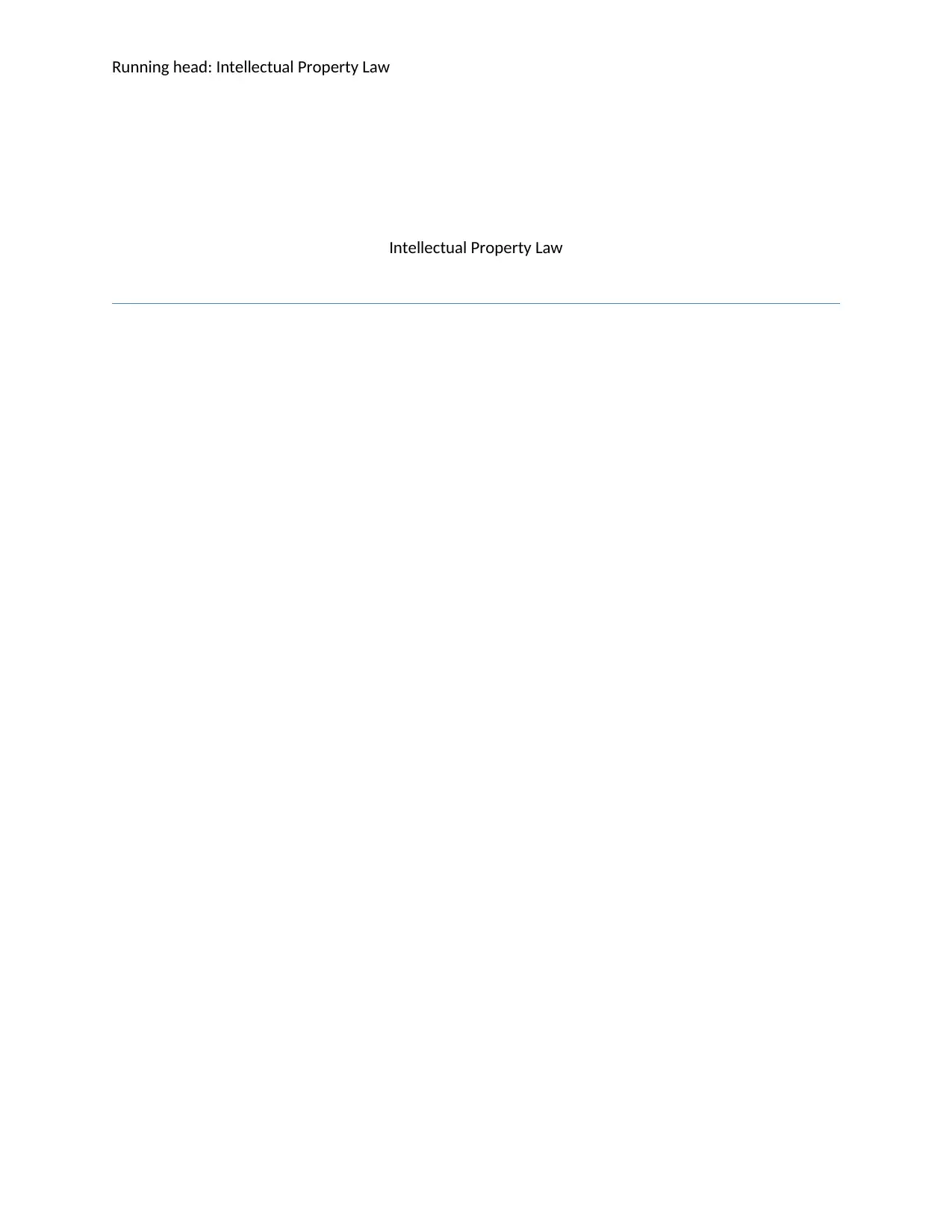
Running head: Intellectual Property Law
Intellectual Property Law
Intellectual Property Law
Paraphrase This Document
Need a fresh take? Get an instant paraphrase of this document with our AI Paraphraser
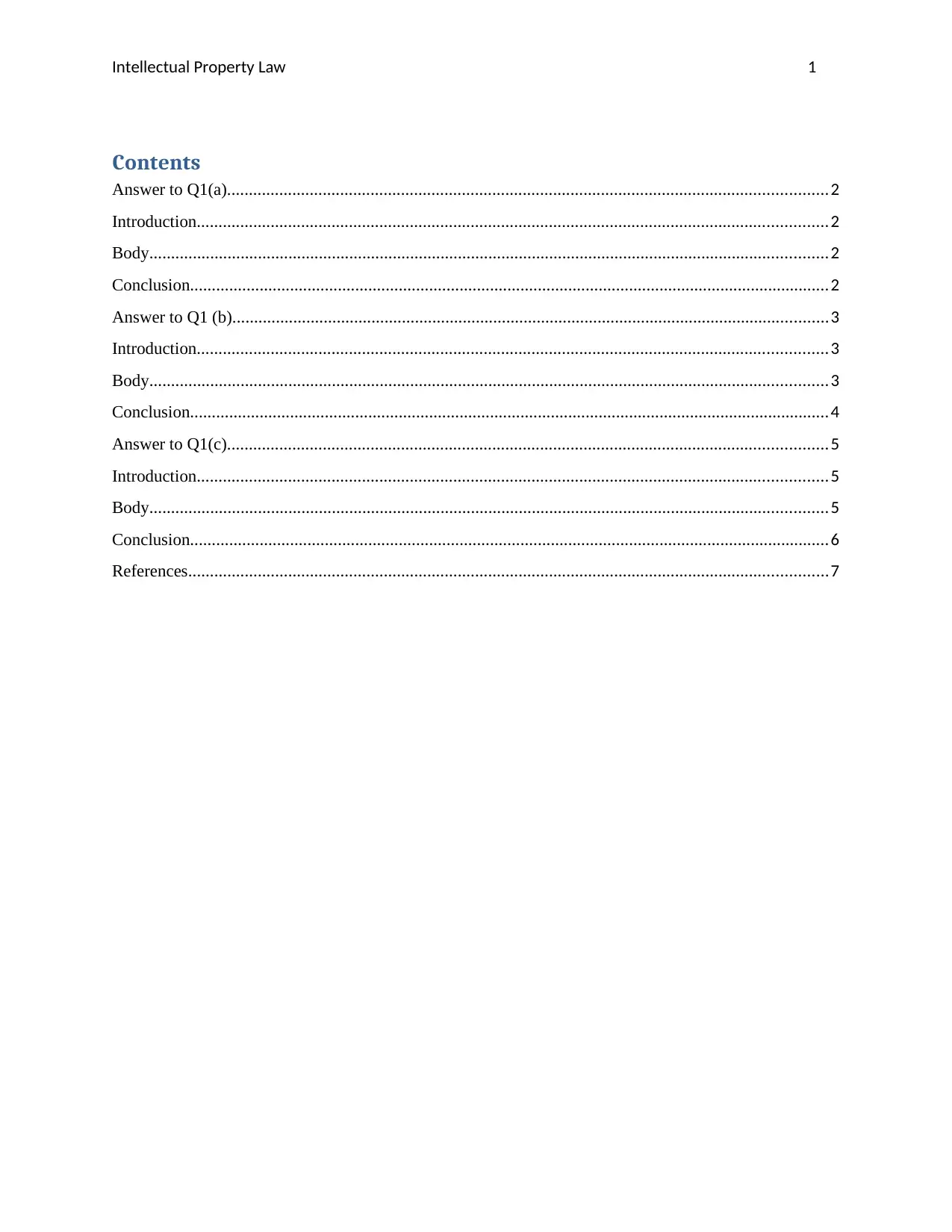
Intellectual Property Law 1
Contents
Answer to Q1(a)..........................................................................................................................................2
Introduction.................................................................................................................................................2
Body............................................................................................................................................................2
Conclusion...................................................................................................................................................2
Answer to Q1 (b).........................................................................................................................................3
Introduction.................................................................................................................................................3
Body............................................................................................................................................................3
Conclusion...................................................................................................................................................4
Answer to Q1(c)..........................................................................................................................................5
Introduction.................................................................................................................................................5
Body............................................................................................................................................................5
Conclusion...................................................................................................................................................6
References...................................................................................................................................................7
Contents
Answer to Q1(a)..........................................................................................................................................2
Introduction.................................................................................................................................................2
Body............................................................................................................................................................2
Conclusion...................................................................................................................................................2
Answer to Q1 (b).........................................................................................................................................3
Introduction.................................................................................................................................................3
Body............................................................................................................................................................3
Conclusion...................................................................................................................................................4
Answer to Q1(c)..........................................................................................................................................5
Introduction.................................................................................................................................................5
Body............................................................................................................................................................5
Conclusion...................................................................................................................................................6
References...................................................................................................................................................7
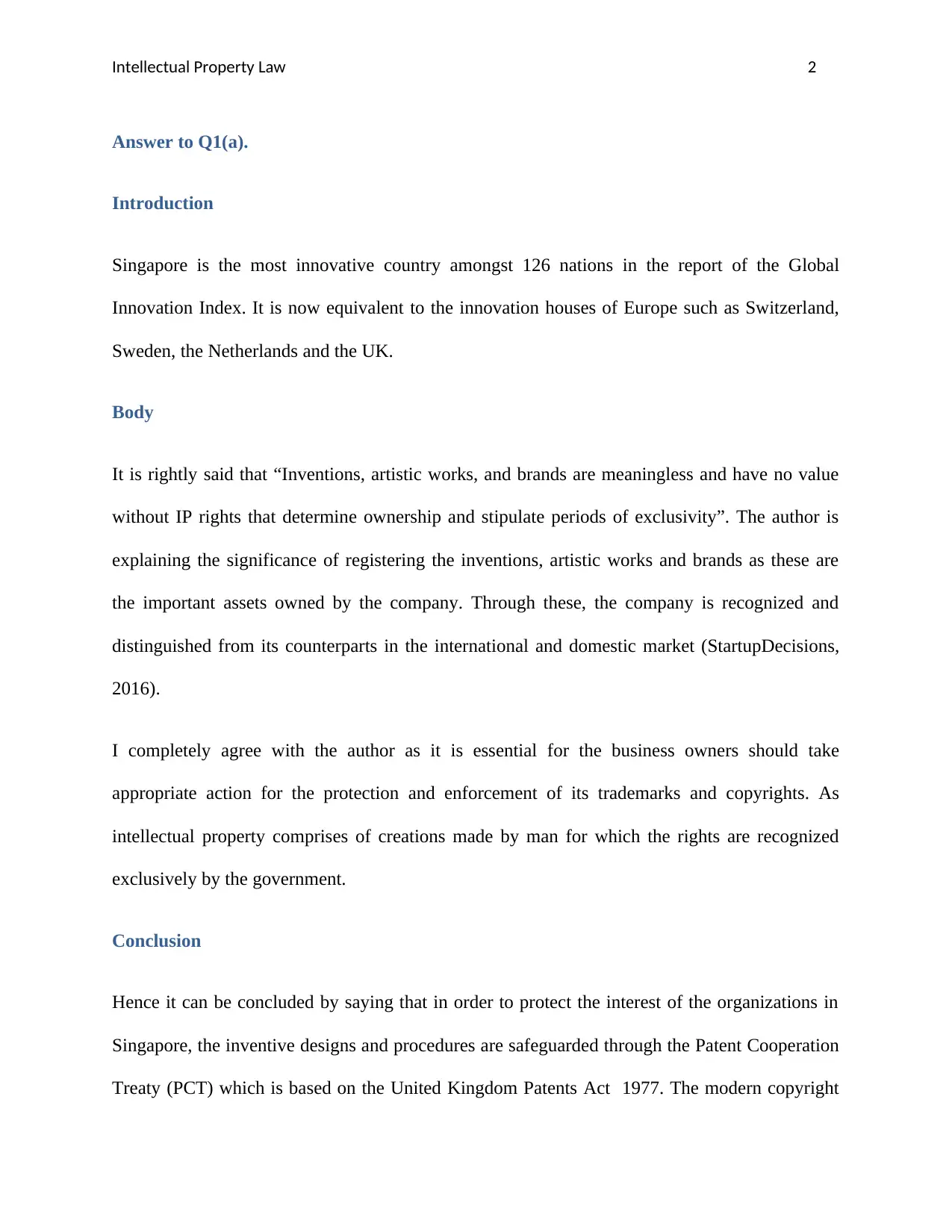
Intellectual Property Law 2
Answer to Q1(a).
Introduction
Singapore is the most innovative country amongst 126 nations in the report of the Global
Innovation Index. It is now equivalent to the innovation houses of Europe such as Switzerland,
Sweden, the Netherlands and the UK.
Body
It is rightly said that “Inventions, artistic works, and brands are meaningless and have no value
without IP rights that determine ownership and stipulate periods of exclusivity”. The author is
explaining the significance of registering the inventions, artistic works and brands as these are
the important assets owned by the company. Through these, the company is recognized and
distinguished from its counterparts in the international and domestic market (StartupDecisions,
2016).
I completely agree with the author as it is essential for the business owners should take
appropriate action for the protection and enforcement of its trademarks and copyrights. As
intellectual property comprises of creations made by man for which the rights are recognized
exclusively by the government.
Conclusion
Hence it can be concluded by saying that in order to protect the interest of the organizations in
Singapore, the inventive designs and procedures are safeguarded through the Patent Cooperation
Treaty (PCT) which is based on the United Kingdom Patents Act 1977. The modern copyright
Answer to Q1(a).
Introduction
Singapore is the most innovative country amongst 126 nations in the report of the Global
Innovation Index. It is now equivalent to the innovation houses of Europe such as Switzerland,
Sweden, the Netherlands and the UK.
Body
It is rightly said that “Inventions, artistic works, and brands are meaningless and have no value
without IP rights that determine ownership and stipulate periods of exclusivity”. The author is
explaining the significance of registering the inventions, artistic works and brands as these are
the important assets owned by the company. Through these, the company is recognized and
distinguished from its counterparts in the international and domestic market (StartupDecisions,
2016).
I completely agree with the author as it is essential for the business owners should take
appropriate action for the protection and enforcement of its trademarks and copyrights. As
intellectual property comprises of creations made by man for which the rights are recognized
exclusively by the government.
Conclusion
Hence it can be concluded by saying that in order to protect the interest of the organizations in
Singapore, the inventive designs and procedures are safeguarded through the Patent Cooperation
Treaty (PCT) which is based on the United Kingdom Patents Act 1977. The modern copyright
⊘ This is a preview!⊘
Do you want full access?
Subscribe today to unlock all pages.

Trusted by 1+ million students worldwide
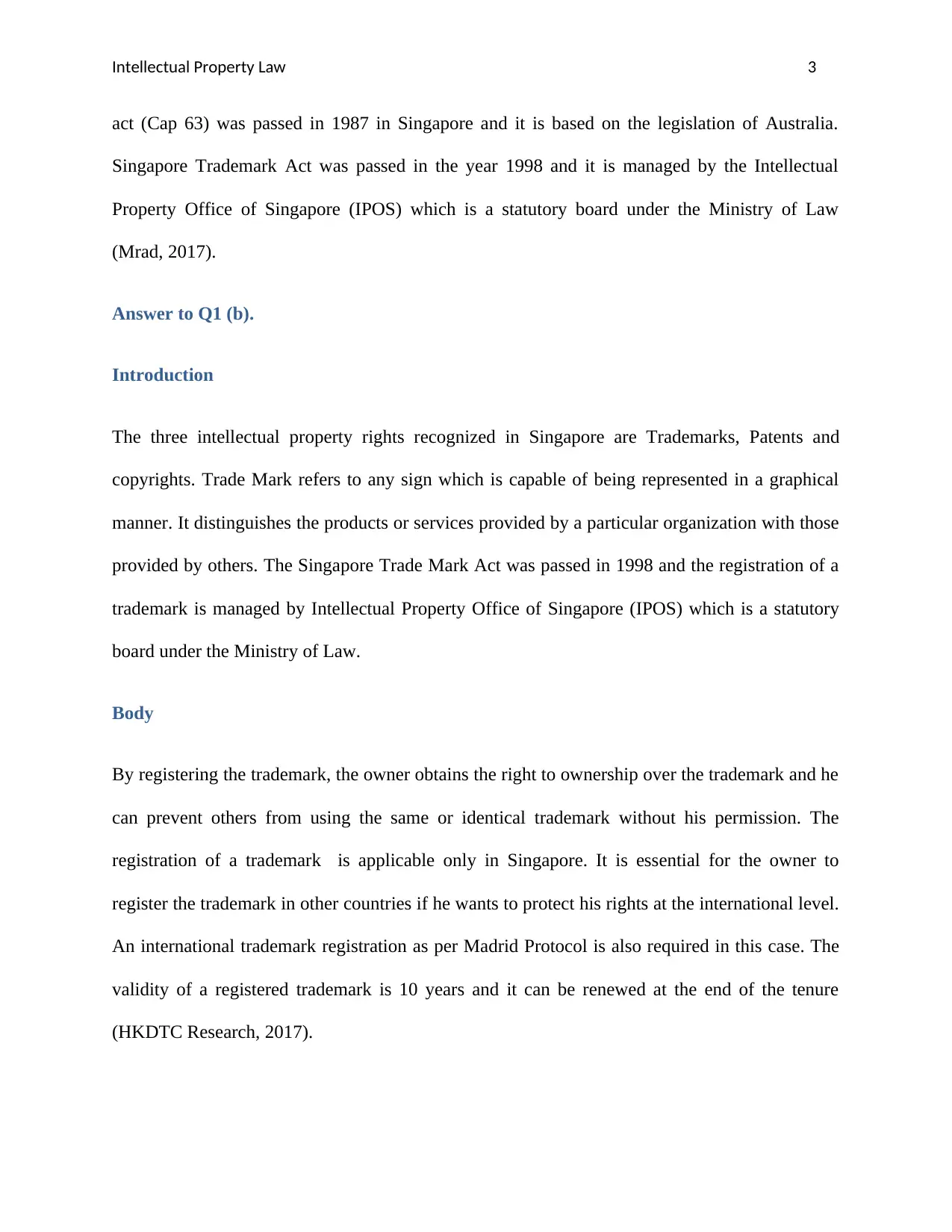
Intellectual Property Law 3
act (Cap 63) was passed in 1987 in Singapore and it is based on the legislation of Australia.
Singapore Trademark Act was passed in the year 1998 and it is managed by the Intellectual
Property Office of Singapore (IPOS) which is a statutory board under the Ministry of Law
(Mrad, 2017).
Answer to Q1 (b).
Introduction
The three intellectual property rights recognized in Singapore are Trademarks, Patents and
copyrights. Trade Mark refers to any sign which is capable of being represented in a graphical
manner. It distinguishes the products or services provided by a particular organization with those
provided by others. The Singapore Trade Mark Act was passed in 1998 and the registration of a
trademark is managed by Intellectual Property Office of Singapore (IPOS) which is a statutory
board under the Ministry of Law.
Body
By registering the trademark, the owner obtains the right to ownership over the trademark and he
can prevent others from using the same or identical trademark without his permission. The
registration of a trademark is applicable only in Singapore. It is essential for the owner to
register the trademark in other countries if he wants to protect his rights at the international level.
An international trademark registration as per Madrid Protocol is also required in this case. The
validity of a registered trademark is 10 years and it can be renewed at the end of the tenure
(HKDTC Research, 2017).
act (Cap 63) was passed in 1987 in Singapore and it is based on the legislation of Australia.
Singapore Trademark Act was passed in the year 1998 and it is managed by the Intellectual
Property Office of Singapore (IPOS) which is a statutory board under the Ministry of Law
(Mrad, 2017).
Answer to Q1 (b).
Introduction
The three intellectual property rights recognized in Singapore are Trademarks, Patents and
copyrights. Trade Mark refers to any sign which is capable of being represented in a graphical
manner. It distinguishes the products or services provided by a particular organization with those
provided by others. The Singapore Trade Mark Act was passed in 1998 and the registration of a
trademark is managed by Intellectual Property Office of Singapore (IPOS) which is a statutory
board under the Ministry of Law.
Body
By registering the trademark, the owner obtains the right to ownership over the trademark and he
can prevent others from using the same or identical trademark without his permission. The
registration of a trademark is applicable only in Singapore. It is essential for the owner to
register the trademark in other countries if he wants to protect his rights at the international level.
An international trademark registration as per Madrid Protocol is also required in this case. The
validity of a registered trademark is 10 years and it can be renewed at the end of the tenure
(HKDTC Research, 2017).
Paraphrase This Document
Need a fresh take? Get an instant paraphrase of this document with our AI Paraphraser
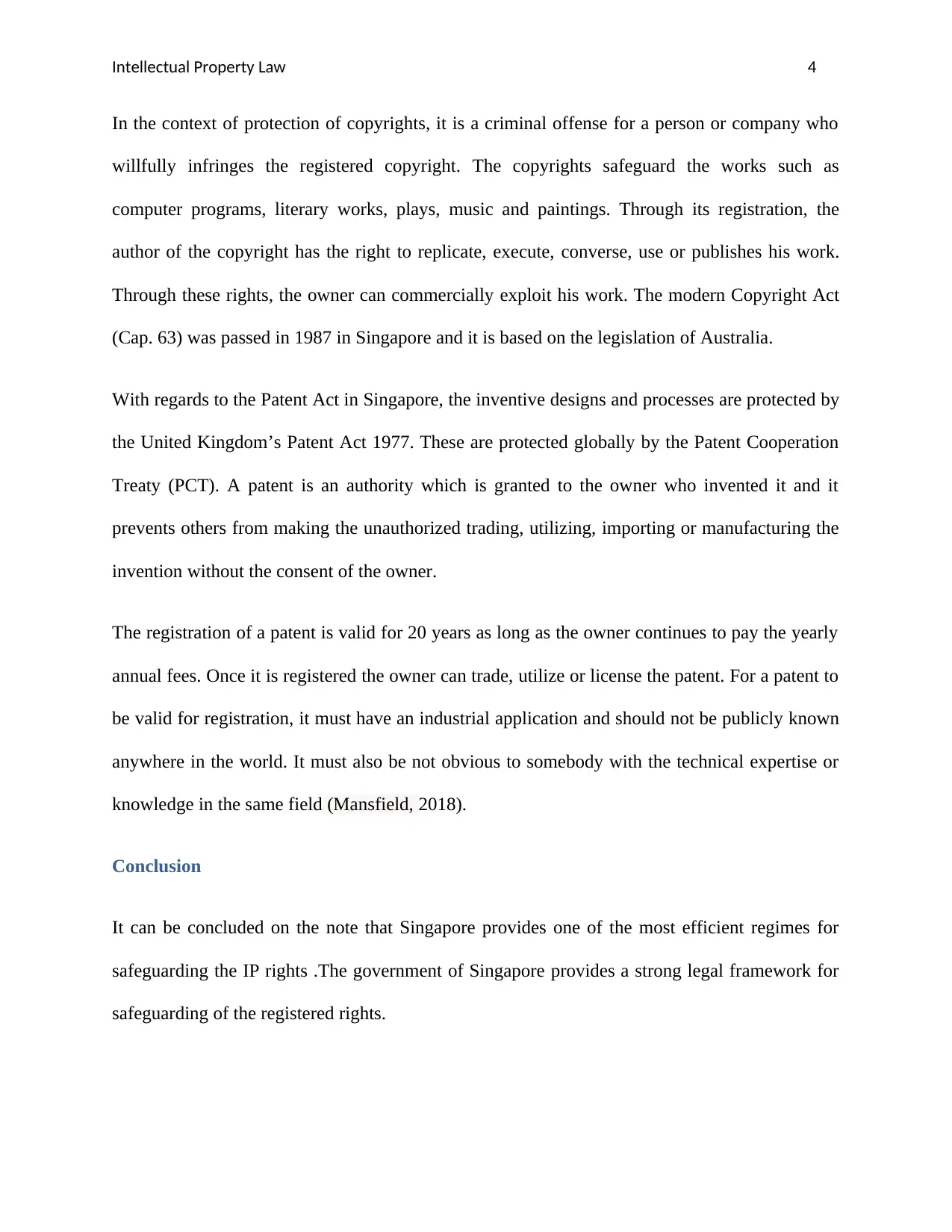
Intellectual Property Law 4
In the context of protection of copyrights, it is a criminal offense for a person or company who
willfully infringes the registered copyright. The copyrights safeguard the works such as
computer programs, literary works, plays, music and paintings. Through its registration, the
author of the copyright has the right to replicate, execute, converse, use or publishes his work.
Through these rights, the owner can commercially exploit his work. The modern Copyright Act
(Cap. 63) was passed in 1987 in Singapore and it is based on the legislation of Australia.
With regards to the Patent Act in Singapore, the inventive designs and processes are protected by
the United Kingdom’s Patent Act 1977. These are protected globally by the Patent Cooperation
Treaty (PCT). A patent is an authority which is granted to the owner who invented it and it
prevents others from making the unauthorized trading, utilizing, importing or manufacturing the
invention without the consent of the owner.
The registration of a patent is valid for 20 years as long as the owner continues to pay the yearly
annual fees. Once it is registered the owner can trade, utilize or license the patent. For a patent to
be valid for registration, it must have an industrial application and should not be publicly known
anywhere in the world. It must also be not obvious to somebody with the technical expertise or
knowledge in the same field (Mansfield, 2018).
Conclusion
It can be concluded on the note that Singapore provides one of the most efficient regimes for
safeguarding the IP rights .The government of Singapore provides a strong legal framework for
safeguarding of the registered rights.
In the context of protection of copyrights, it is a criminal offense for a person or company who
willfully infringes the registered copyright. The copyrights safeguard the works such as
computer programs, literary works, plays, music and paintings. Through its registration, the
author of the copyright has the right to replicate, execute, converse, use or publishes his work.
Through these rights, the owner can commercially exploit his work. The modern Copyright Act
(Cap. 63) was passed in 1987 in Singapore and it is based on the legislation of Australia.
With regards to the Patent Act in Singapore, the inventive designs and processes are protected by
the United Kingdom’s Patent Act 1977. These are protected globally by the Patent Cooperation
Treaty (PCT). A patent is an authority which is granted to the owner who invented it and it
prevents others from making the unauthorized trading, utilizing, importing or manufacturing the
invention without the consent of the owner.
The registration of a patent is valid for 20 years as long as the owner continues to pay the yearly
annual fees. Once it is registered the owner can trade, utilize or license the patent. For a patent to
be valid for registration, it must have an industrial application and should not be publicly known
anywhere in the world. It must also be not obvious to somebody with the technical expertise or
knowledge in the same field (Mansfield, 2018).
Conclusion
It can be concluded on the note that Singapore provides one of the most efficient regimes for
safeguarding the IP rights .The government of Singapore provides a strong legal framework for
safeguarding of the registered rights.
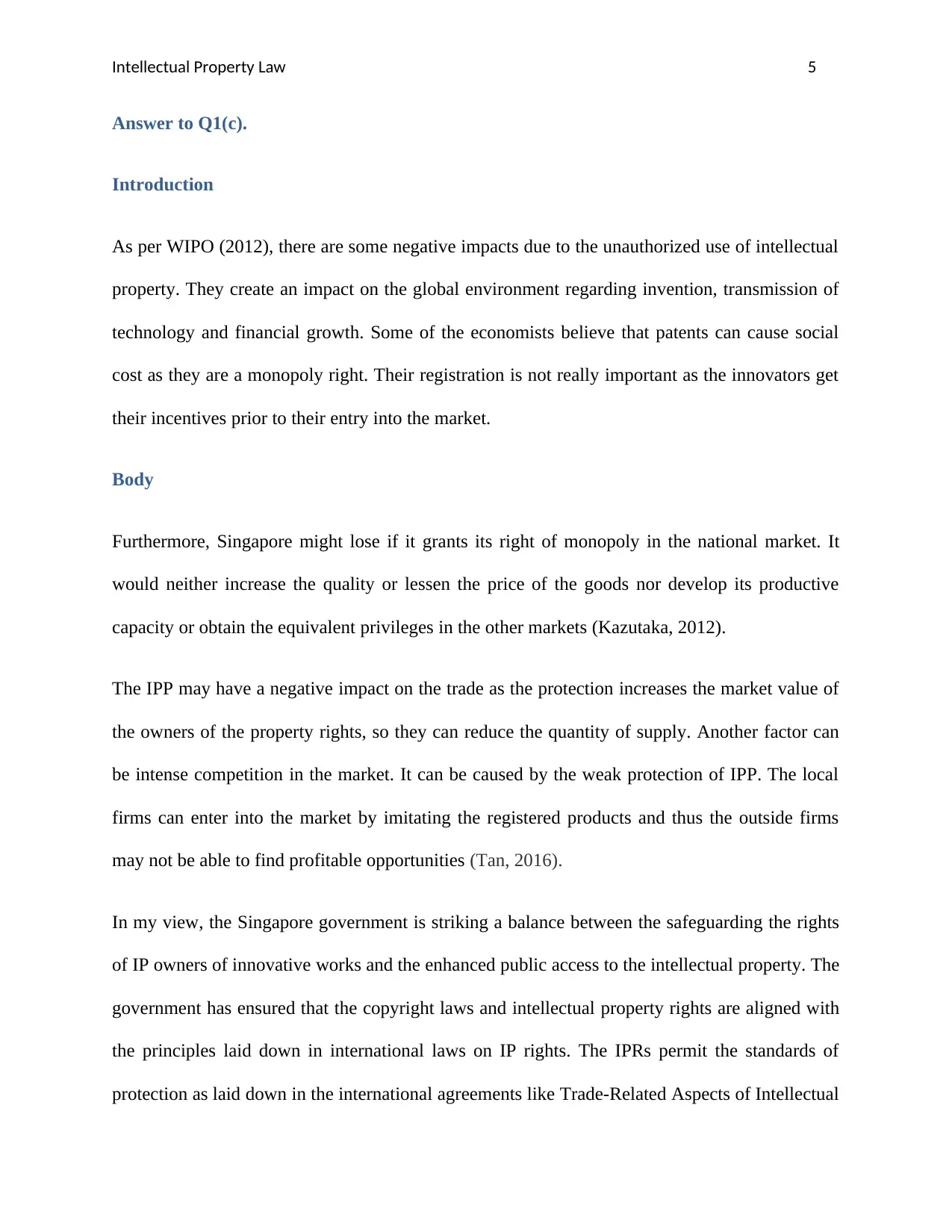
Intellectual Property Law 5
Answer to Q1(c).
Introduction
As per WIPO (2012), there are some negative impacts due to the unauthorized use of intellectual
property. They create an impact on the global environment regarding invention, transmission of
technology and financial growth. Some of the economists believe that patents can cause social
cost as they are a monopoly right. Their registration is not really important as the innovators get
their incentives prior to their entry into the market.
Body
Furthermore, Singapore might lose if it grants its right of monopoly in the national market. It
would neither increase the quality or lessen the price of the goods nor develop its productive
capacity or obtain the equivalent privileges in the other markets (Kazutaka, 2012).
The IPP may have a negative impact on the trade as the protection increases the market value of
the owners of the property rights, so they can reduce the quantity of supply. Another factor can
be intense competition in the market. It can be caused by the weak protection of IPP. The local
firms can enter into the market by imitating the registered products and thus the outside firms
may not be able to find profitable opportunities (Tan, 2016).
In my view, the Singapore government is striking a balance between the safeguarding the rights
of IP owners of innovative works and the enhanced public access to the intellectual property. The
government has ensured that the copyright laws and intellectual property rights are aligned with
the principles laid down in international laws on IP rights. The IPRs permit the standards of
protection as laid down in the international agreements like Trade-Related Aspects of Intellectual
Answer to Q1(c).
Introduction
As per WIPO (2012), there are some negative impacts due to the unauthorized use of intellectual
property. They create an impact on the global environment regarding invention, transmission of
technology and financial growth. Some of the economists believe that patents can cause social
cost as they are a monopoly right. Their registration is not really important as the innovators get
their incentives prior to their entry into the market.
Body
Furthermore, Singapore might lose if it grants its right of monopoly in the national market. It
would neither increase the quality or lessen the price of the goods nor develop its productive
capacity or obtain the equivalent privileges in the other markets (Kazutaka, 2012).
The IPP may have a negative impact on the trade as the protection increases the market value of
the owners of the property rights, so they can reduce the quantity of supply. Another factor can
be intense competition in the market. It can be caused by the weak protection of IPP. The local
firms can enter into the market by imitating the registered products and thus the outside firms
may not be able to find profitable opportunities (Tan, 2016).
In my view, the Singapore government is striking a balance between the safeguarding the rights
of IP owners of innovative works and the enhanced public access to the intellectual property. The
government has ensured that the copyright laws and intellectual property rights are aligned with
the principles laid down in international laws on IP rights. The IPRs permit the standards of
protection as laid down in the international agreements like Trade-Related Aspects of Intellectual
⊘ This is a preview!⊘
Do you want full access?
Subscribe today to unlock all pages.

Trusted by 1+ million students worldwide
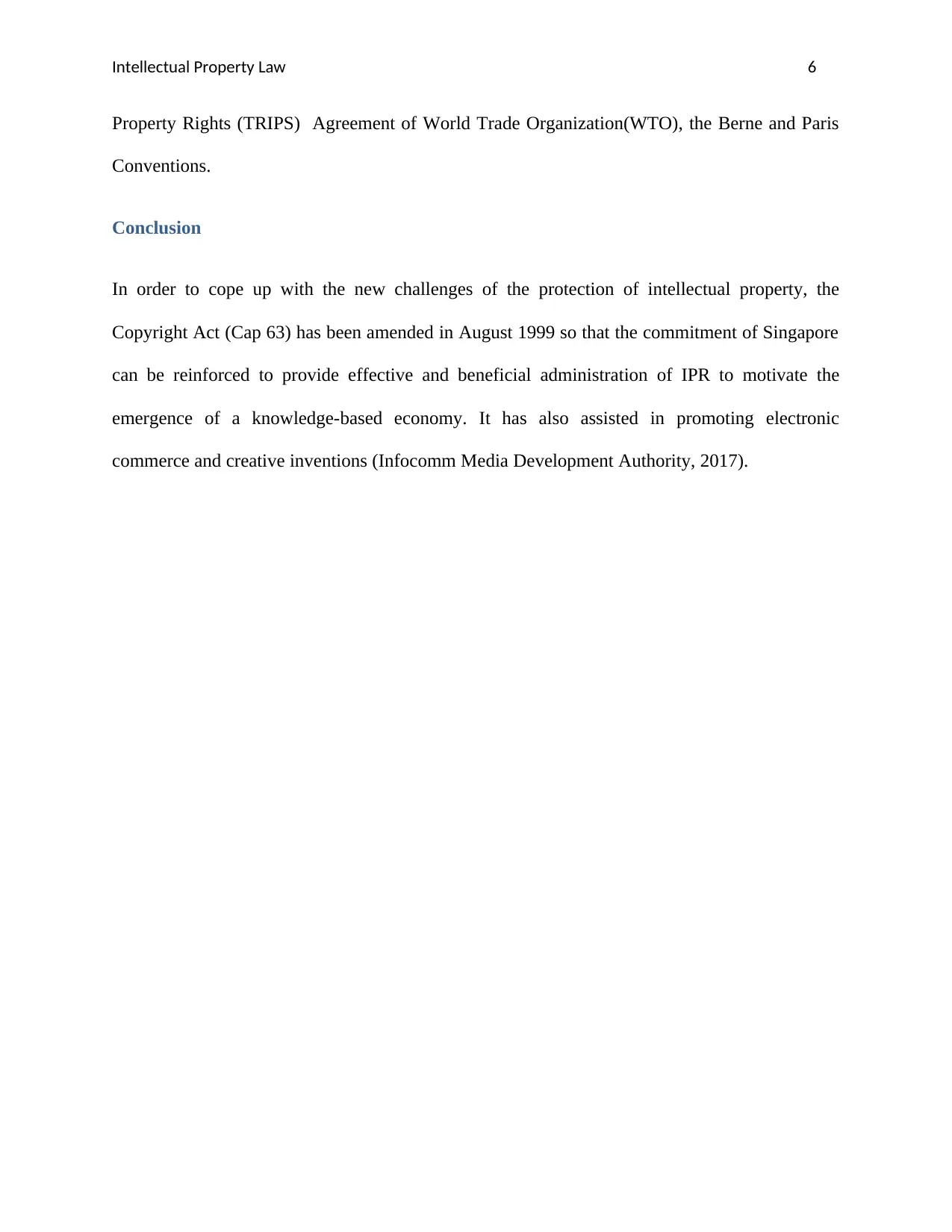
Intellectual Property Law 6
Property Rights (TRIPS) Agreement of World Trade Organization(WTO), the Berne and Paris
Conventions.
Conclusion
In order to cope up with the new challenges of the protection of intellectual property, the
Copyright Act (Cap 63) has been amended in August 1999 so that the commitment of Singapore
can be reinforced to provide effective and beneficial administration of IPR to motivate the
emergence of a knowledge-based economy. It has also assisted in promoting electronic
commerce and creative inventions (Infocomm Media Development Authority, 2017).
Property Rights (TRIPS) Agreement of World Trade Organization(WTO), the Berne and Paris
Conventions.
Conclusion
In order to cope up with the new challenges of the protection of intellectual property, the
Copyright Act (Cap 63) has been amended in August 1999 so that the commitment of Singapore
can be reinforced to provide effective and beneficial administration of IPR to motivate the
emergence of a knowledge-based economy. It has also assisted in promoting electronic
commerce and creative inventions (Infocomm Media Development Authority, 2017).
Paraphrase This Document
Need a fresh take? Get an instant paraphrase of this document with our AI Paraphraser
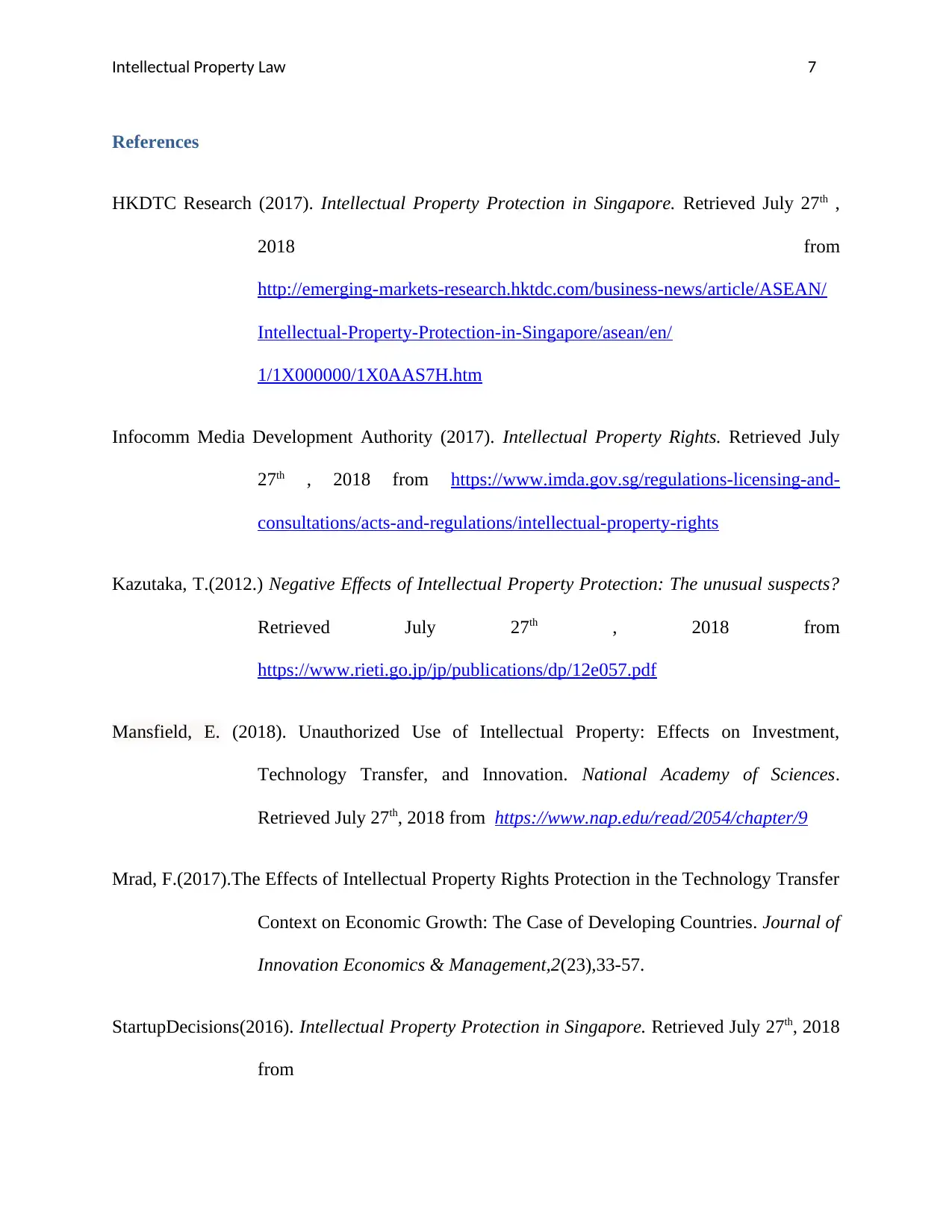
Intellectual Property Law 7
References
HKDTC Research (2017). Intellectual Property Protection in Singapore. Retrieved July 27th ,
2018 from
http://emerging-markets-research.hktdc.com/business-news/article/ASEAN/
Intellectual-Property-Protection-in-Singapore/asean/en/
1/1X000000/1X0AAS7H.htm
Infocomm Media Development Authority (2017). Intellectual Property Rights. Retrieved July
27th , 2018 from https://www.imda.gov.sg/regulations-licensing-and-
consultations/acts-and-regulations/intellectual-property-rights
Kazutaka, T.(2012.) Negative Effects of Intellectual Property Protection: The unusual suspects?
Retrieved July 27th , 2018 from
https://www.rieti.go.jp/jp/publications/dp/12e057.pdf
Mansfield, E. (2018). Unauthorized Use of Intellectual Property: Effects on Investment,
Technology Transfer, and Innovation. National Academy of Sciences.
Retrieved July 27th, 2018 from https://www.nap.edu/read/2054/chapter/9
Mrad, F.(2017).The Effects of Intellectual Property Rights Protection in the Technology Transfer
Context on Economic Growth: The Case of Developing Countries. Journal of
Innovation Economics & Management,2(23),33-57.
StartupDecisions(2016). Intellectual Property Protection in Singapore. Retrieved July 27th, 2018
from
References
HKDTC Research (2017). Intellectual Property Protection in Singapore. Retrieved July 27th ,
2018 from
http://emerging-markets-research.hktdc.com/business-news/article/ASEAN/
Intellectual-Property-Protection-in-Singapore/asean/en/
1/1X000000/1X0AAS7H.htm
Infocomm Media Development Authority (2017). Intellectual Property Rights. Retrieved July
27th , 2018 from https://www.imda.gov.sg/regulations-licensing-and-
consultations/acts-and-regulations/intellectual-property-rights
Kazutaka, T.(2012.) Negative Effects of Intellectual Property Protection: The unusual suspects?
Retrieved July 27th , 2018 from
https://www.rieti.go.jp/jp/publications/dp/12e057.pdf
Mansfield, E. (2018). Unauthorized Use of Intellectual Property: Effects on Investment,
Technology Transfer, and Innovation. National Academy of Sciences.
Retrieved July 27th, 2018 from https://www.nap.edu/read/2054/chapter/9
Mrad, F.(2017).The Effects of Intellectual Property Rights Protection in the Technology Transfer
Context on Economic Growth: The Case of Developing Countries. Journal of
Innovation Economics & Management,2(23),33-57.
StartupDecisions(2016). Intellectual Property Protection in Singapore. Retrieved July 27th, 2018
from
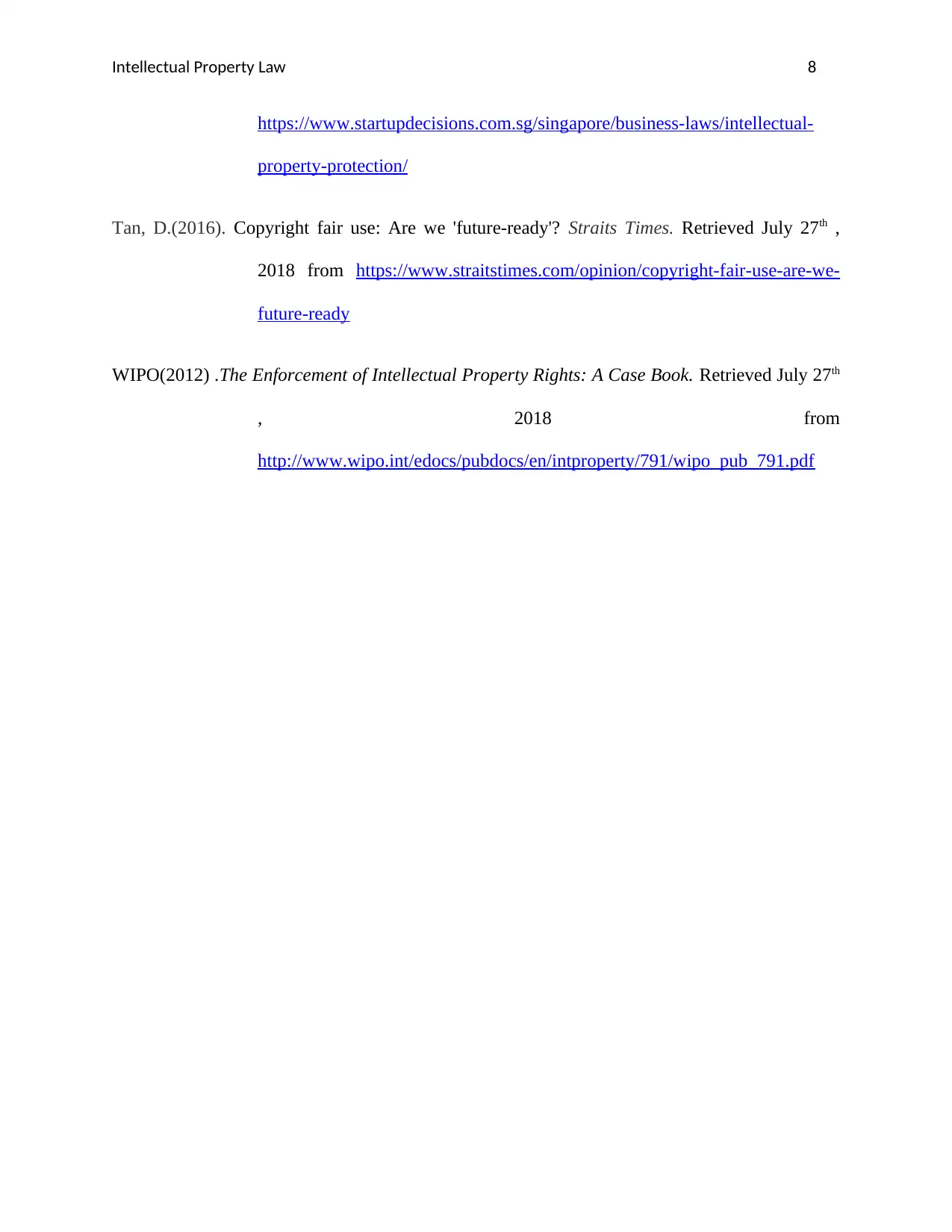
Intellectual Property Law 8
https://www.startupdecisions.com.sg/singapore/business-laws/intellectual-
property-protection/
Tan, D.(2016). Copyright fair use: Are we 'future-ready'? Straits Times. Retrieved July 27th ,
2018 from https://www.straitstimes.com/opinion/copyright-fair-use-are-we-
future-ready
WIPO(2012) .The Enforcement of Intellectual Property Rights: A Case Book. Retrieved July 27th
, 2018 from
http://www.wipo.int/edocs/pubdocs/en/intproperty/791/wipo_pub_791.pdf
https://www.startupdecisions.com.sg/singapore/business-laws/intellectual-
property-protection/
Tan, D.(2016). Copyright fair use: Are we 'future-ready'? Straits Times. Retrieved July 27th ,
2018 from https://www.straitstimes.com/opinion/copyright-fair-use-are-we-
future-ready
WIPO(2012) .The Enforcement of Intellectual Property Rights: A Case Book. Retrieved July 27th
, 2018 from
http://www.wipo.int/edocs/pubdocs/en/intproperty/791/wipo_pub_791.pdf
⊘ This is a preview!⊘
Do you want full access?
Subscribe today to unlock all pages.

Trusted by 1+ million students worldwide
1 out of 9
Related Documents
Your All-in-One AI-Powered Toolkit for Academic Success.
+13062052269
info@desklib.com
Available 24*7 on WhatsApp / Email
![[object Object]](/_next/static/media/star-bottom.7253800d.svg)
Unlock your academic potential
Copyright © 2020–2025 A2Z Services. All Rights Reserved. Developed and managed by ZUCOL.




